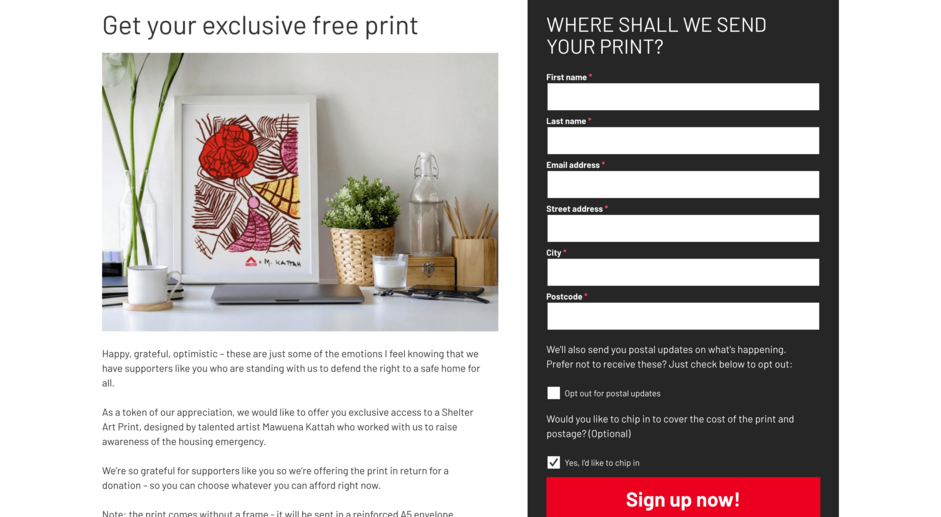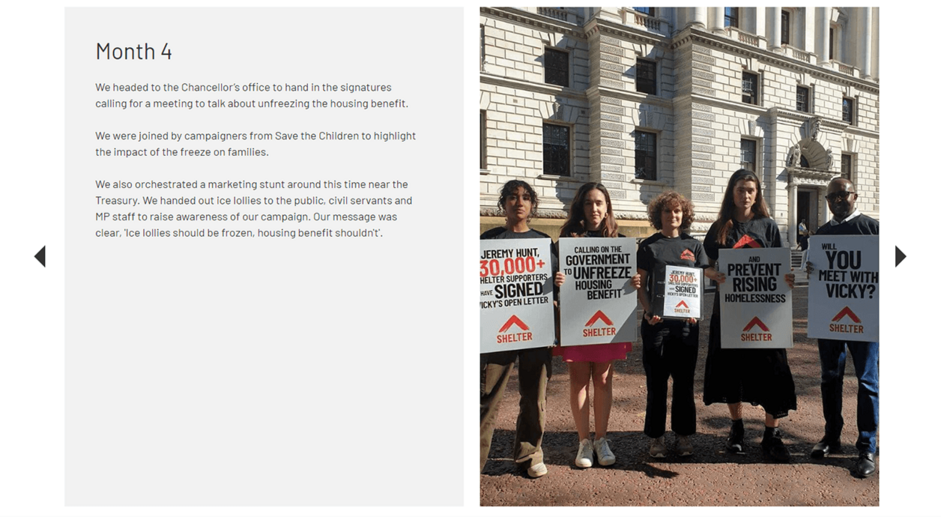Up until 2023, Shelter had the same eight-email welcome journey for all of their new donors. Only one email in this journey was tailored to reflect which of these categories the supporter was in, and in most cases, this was the best performing email. So they approached More Onion to help them design new welcome journeys - one for their onetime donors, and one for their regular donors.
Most of the content for the new journeys is delivered via email (where email contact consent exists) with postal content adding richness along the way (where postal consent exists).
Each of the welcome journeys is designed to be delivered automatically on a timescale to suit the supporter - your journey begins when you first give contact consent. This allows the development of whole and consistent journeys, in the knowledge that each supporter will get the content at the right time for them. It also creates some fantastic opportunities for testing and optimisation.
Note: we also worked on a welcome journey for lottery players - read about the lottery welcome journey here.
Strategy development
Through the strategy phase of the project it was very clear that not only were these two individual giving audiences very different in terms of their knowledge, interests and motivations, but the charity’s goals for them were also completely distinct.
Therefore, during the strategy phase we developed distinct strategies for each journey.
One-time donor welcome journey
The welcome journey for first time donors making a one-off gift had the primary objective of getting as many new supporters as possible to give again, especially in their first six months with the charity.
Audience analysis showed us that this audience wanted to actively decide what to give their money to and to receive timely and tangible asks. With this in mind, we knew they would need regular communications with compelling storytelling and opportunities for engagement where the impact was clear.
Regular donor welcome journey
For the regular donor journey, our focus was retention, i.e. getting as many people as possible to keep their monthly donations going.
Audience analysis showed that this audience preferred to be more or less left alone. They enjoy the convenience of giving automatically and trust the charity to spend the money well. So for this journey we focus on fewer, higher quality communications.
Creative content development
With the strategies and audience profiles in hand, we developed and facilitated fun and active creative sessions with a broader Shelter team. Staff for a range of teams generated hundreds of ideas per journey for content that could help achieve our objectives. For cash donors we generated lots of ideas for active and fun ways people can learn more and support the cause, and for regular donors we focused on high quality and engaging storytelling.
We sorted through and developed the best ideas in tandem with the Shelter team, bringing some of the ideas to life on Impact Stack.
“The ideation sessions run by More Onion were really well facilitated - we got great feedback from other people who took part. Everyone had fun and we generated loads of really great ideas.”
Josie Isherwood, Senior Direct Marketing Manager, Shelter
A robust testing programme
One of the advantages of an automated welcome programme is that you can constantly improve it. The journey that you launch is just the starting point. By reviewing real data you can see what your supporters respond well to and what to adapt or scrap, meaning that the journeys get stronger year on year.
Content tests were integrated for key pieces of content across the journeys, in addition to tests that ran the entire length of the journeys.
The overarching journey tests ran for the whole duration of the journeys. These allowed us to gather data on how we can boost overall journey performance by altering something about the journey itself: the pacing of the emails or the balance of content types for example. Here are the overarching tests that we chose to start with:
Onetime donor journey
Question: Can we send the emails in quicker succession without affecting the overall performance?
Variable: average gap between emails.
Regular donor journey
Question: Do regular donors stay with us longer if we communicate less, or if we also ask them to support us through non-financial actions (i.e. campaigning)?
Variable: inclusion or exclusion of campaigning asks on top of standard loyalty and engagement emails.

These long term tests are a fantastic opportunity to learn and improve supporter experience. The only downside… the data takes a long time to get! The journeys are live at the moment and we hope to have enough data to analyse the results in 2025. Feel free to reach out if you’d like to hear more.
In the meantime you can learn more about optimisation testing with this free report.
One thing that really stands out when working More Onion is their focus on more strategic testing and building journeys that will optimise over time, not setting something up that works and seeing the job as 'done'. Everything is set up to look for improvements over time.






